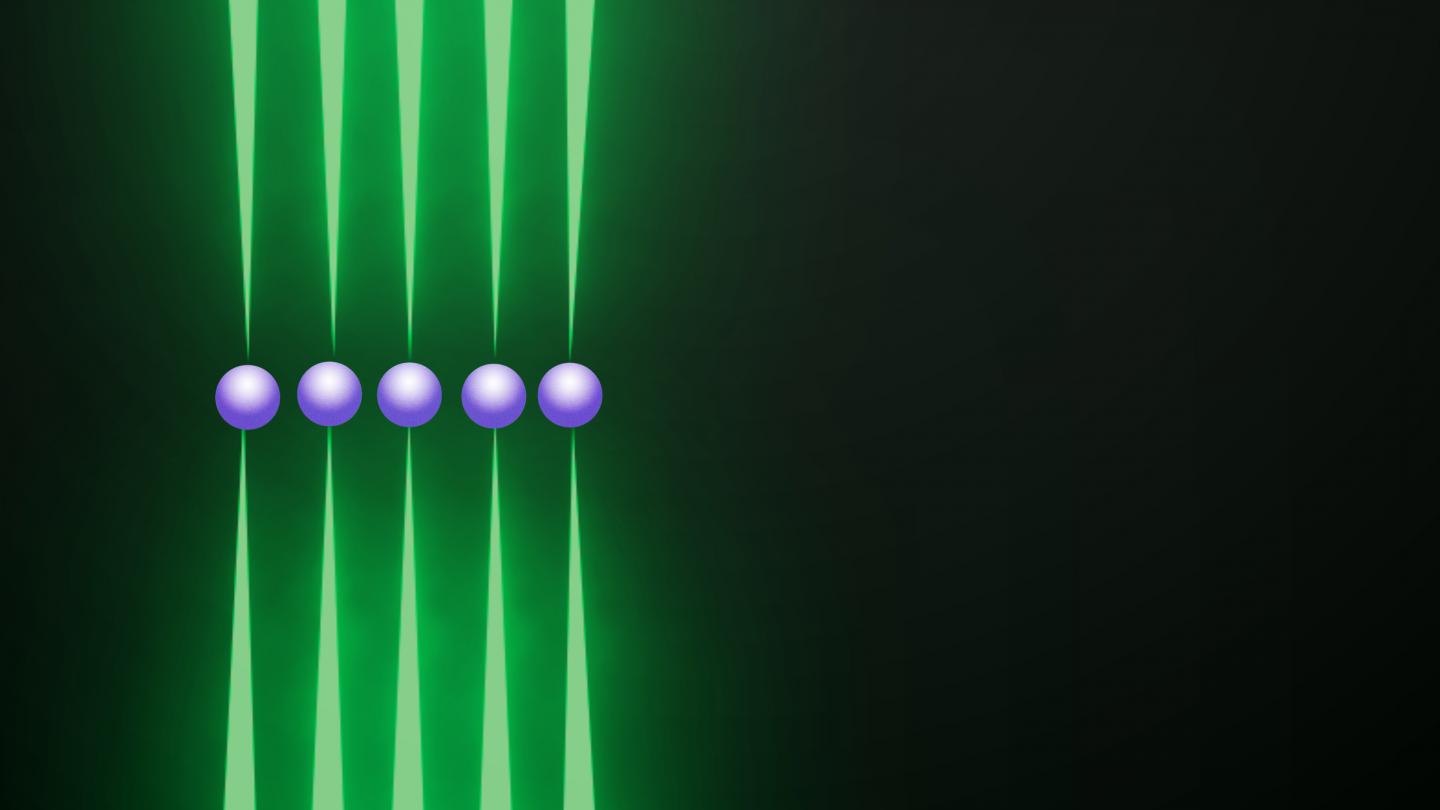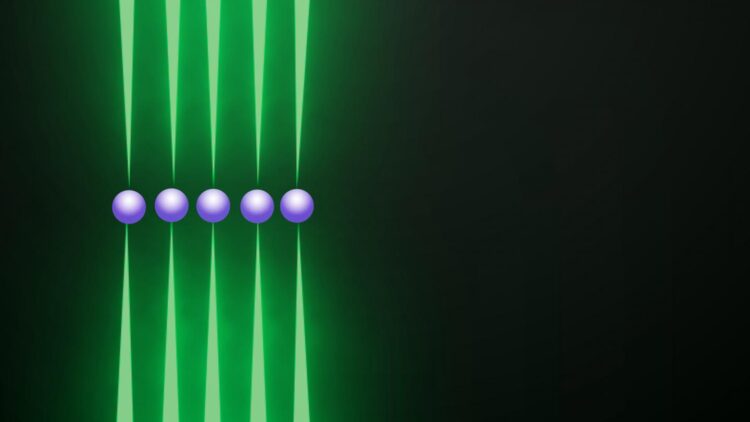
Credit: NIST
JILA physicists have boosted the signal power of their atomic “tweezer clock” and measured its performance in part for the first time, demonstrating high stability close to the best of the latest generation of atomic clocks.
The unusual clock, which uses laser tweezers to trap, control and isolate atoms, offers unique possibilities for enhancing clock performance using the tricks of quantum physics as well as future applications in quantum information processing, quantum simulation, and measurement science.
Described in a Nature paper published online Dec. 16, the clock platform is a rectangular grid of about 150 strontium atoms confined individually by optical tweezers, which are created by a laser beam aimed through a microscope and deflected into 320 spots. This upgraded version of the clock has up to 30 times as many atoms as the preliminary design unveiled last year, due mainly to the use of several different lasers, including a green one for trapping the atoms and two red ones to make them “tick.”
Once the laser started atoms ticking in the experiments described in the paper, a selection of these atoms kept vibrating in unison at the same frequency for more than 30 seconds, a record for what is called quantum coherence. The large number of atoms and their long coherence times resulted in excellent clock stability of 5.2 x 10-17at 1 second averaging time. This means that the duration of each clock “tick” matches the others to within about 1.9 quintillionths of a second.
Researchers measured the stability by comparing two different regions within the tweezer clock, noting that this performance approaches that of JILA’s 3D strontium lattice clock, for which the internal comparison method was initially developed. The stability of 3D system was later verified with a more conventional comparison between two optical lattice clocks.
JILA is jointly operated by the National Institute of Standards and Technology (NIST) and the University of Colorado Boulder.
“One of the important breakthroughs in this work was that we figured out a method for preparing many atoms while maintaining quantum coherence,” NIST/JILA physicist Adam Kaufman said. “This was key to allowing a 30-fold atom number increase over last year, which also permitted atom numbers sufficient for self-comparisons and the observation of the long coherence time. But, beyond clocks, this combination of scalability, coherence, and single-particle control also sets up this system for quantum information processing and simulation.”
NIST and JILA researchers have been building atomic clocks for many years. The latest clocks operate at optical frequencies, which are much higher than current time standards based on microwave frequencies. The research is helping to prepare for the future international redefinition of the second, which has been based on the cesium atom since 1967. Optical clocks also have applications beyond timekeeping such as enhancing quantum information science.
The tweezer clock combines some of the most desirable features of currently operating optical clocks. For example, like ordinary metal tweezers, the laser tweezers offer pinpoint control of, in this case, individual atoms. The tweezer clock also provides the strong signals and stability provided by many atoms–hundreds now and aiming at more than a thousand tweezers in the future.
To make the clock, researchers load a chilled cloud of atoms in their lowest energy state into a rectangular, two-dimensional array of 320 tweezers (16 by 20) formed by a green laser. Overlapping the tweezers are two crossed laser beams that create a standing wave called an optical lattice. The optical lattice reduces tweezer power requirements to 1/30th of their original level. A new cloud of atoms refills the tweezers every few seconds. A filtering process leaves tweezer sites with either one atom or empty; with each run of the experiment, each tweezer has about a 50% chance of containing a single atom.
The researchers then turn off the green laser and lattice and switch to a red tweezer laser, which requires more power but is conducive to clock behavior. The atoms held by the tweezers are excited by a pink “clock laser” applied perpendicular to the tweezer light, along with a magnetic field. The clock laser excites the atoms, which begin ticking between two internal energy levels. (See animation of how the clock works.) Finally, the green tweezers are turned back on and a camera records the atoms’ state; they fluoresce only at the low energy level, so the ticking is recorded as flashing light and can be converted to a timing signal.
Beyond timekeeping, JILA researchers are excited about using the tweezer platform for other applications such as quantum computing and simulation and programmable quantum sensors. Optical tweezers can be used to “entangle” atoms, a quantum phenomenon that links their properties even at a distance. Special quantum states like entanglement can improve the measurement sensitivity of clocks and sensors and might also be used in quantum logic operations and simulations of quantum processes.
“I think one should really look beyond clocks for this new platform,” NIST/JILA Fellow and co-author Jun Ye said. “With the capability of being able to address each individual atom, one can bring programmability into quantum sensing and information processing, a feature that will be powerful for optimizing the system for specific tasks.”
###
This work was supported by the Army Research Office, Air Force Office of Scientific Research, Defense Advanced Research Projects Agency, National Science Foundation Physics Frontier Center at JILA, and NIST.
Paper: A.W. Young, W.J. Eckner, W.R. Milner, D. Kedar, M.A. Norcia, E. Oelker, N. Schine, J. Ye, and A.M. Kaufman. A tweezer clock with half-minute atomic coherence at optical frequencies and high relative stability. Nature. Published online Dec. 16, 2020.
Media Contact
Laura Ost
[email protected]





